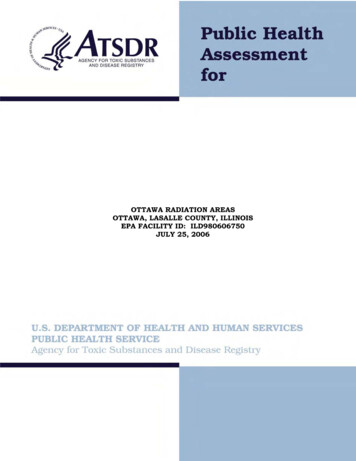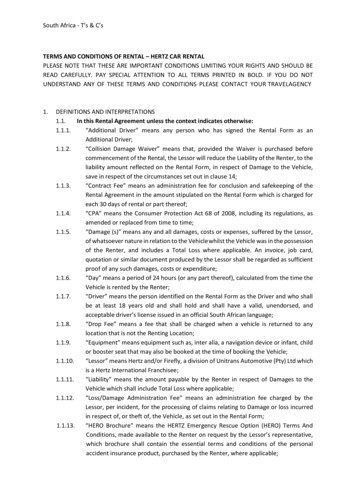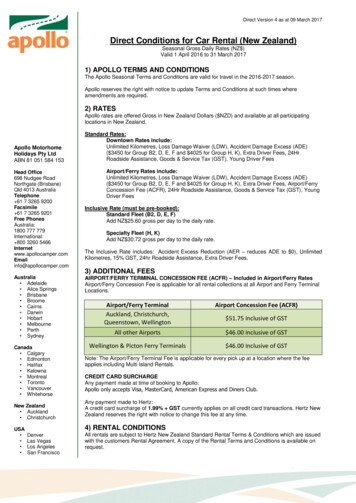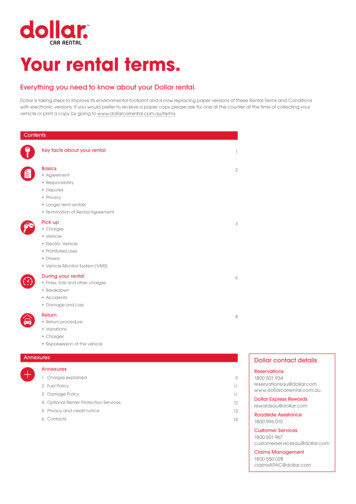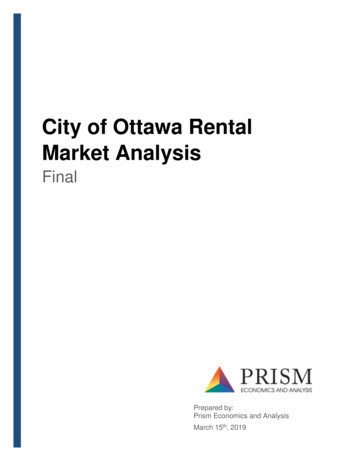
Transcription
City of Ottawa RentalMarket AnalysisFinalPrepared by:Prism Economics and AnalysisMarch 15th, 2019
ContentsCity of Ottawa Rental Market Analysis . 0Executive Summary . 3State of the Rental Market . 3Private Rental Listing Platforms . 4Short-Term Rentals . 4Rental Market Forecast . 51. Introduction. 62. Methodology . 72.1Rental Accommodation Inventory . 72.2State of the Rental Housing Market . 92.3Rental Housing Market Forecast . 9Demographics and Households . 10Dwelling Stock. 11Short-Term Rental Scenarios . 11Affordability Thresholds . 123. Findings from the Rental Housing Inventory. 133.1Profile of Overall Rental Supply . 133.2Profile of Average Rents . 193.3Housing Affordability . 213.4Short-Term Rentals . 244. Findings from the Market Rent Analysis . 275. Rental Market Forecast . 315.1Population and Demographics . 315.2Change in the Housing Stock . 325.3Change in Average Monthly Rent . 375.4Change in Affordability . 395.5Impact of short-term rentals on monthly rents . 40Conclusion . 42Ottawa Rental Market Report1
Table of Figures and Tables:Figure 1 -Dwelling Types: Percent of High-Rise Apartments . 15Figure 2 - Dwelling Types: Percent of Low-Rise Apartments . 16Figure 3 – Starts by Dwelling Type: Ottawa . 17Figure 4 – Starts by Intended Market: Ottawa . 17Figure 5 – Affordability threshold for renters by Census Tract. . 21Figure 6 - Crowding Map, Population per Bedroom . 24Figure 7 – Distribution of Short-term rental Units by Census Tract . 26Figure 8 - Population by Age Group . 31Figure 9– Percentage Change in Population: 2016-2031. 32Figure 10- Number of Dwellings: Status Quo Mix of Starts . 33Figure 11 – Proportion of Housing Stock: Status Quo Mix of Starts . 33Figure 12 - Stock of Dwellings in Housing Forecast . 34Figure 13 – Dwellings by Use in Two Growth Scenarios . 34Figure 14 - Supply/Demand Gaps . 36Figure 15 - Total Dwelling Stock and Number of Households . 36Figure 16 - Total # of Unaffordable Households . 40Figure 17 – Vacancy Rates and Rent Increases, 1992 to 2018 . 40Table 1 (A) – City of Ottawa, Renters and Units, 2016-2018 . 13Table 1 (B) – Ottawa CMA (including Gatineau), Renters and Units, 2016-2018. 13Table 2 – Inventory of housing units by Tenure, City of Ottawa, 2018 . 14Table 3 – Rental Units by Construction Era, Dwelling Types, 2018 . 18Table 4 – Rental Apartments by Construction Era, 2018 . 18Table 5 – Buildings with Rental Units by Estimated Age of Construction, 2018 . 19Table 6 (A) – Apartments . 19Table 6 (B) – Single Detached House . 19Table 7 – Average monthly renter costs by neighbourhood, 2018 . 20Table 8 – Renter affordability threshold and population, 2016 . 22Table 9 – Short-term Rental Listings 2016-2018 . 25Table 10 – Top Five Neighbourhoods for Short-Term Rental. 25Table 11 – Short-term Rentals by Dwelling Type and Bedrooms . 27Table 12 – Market Rent Listings by Bedroom Type, 2018 . 27Table 13 – Average Asking Rent for Market Rentals by Bedroom . 28Table 14 – Growth Targets by Dwelling Type . 37Table 15 – Average Apartment Monthly Rents for the City of Ottawa By Bedroom, 2008to 2031 . 38Table 16 – Average Row Housing Rent by Bedroom, 2008 to 2031 . 39Table 17 – Summary of Short-term Rental Impacts by 2031. 41Ottawa Rental Market Report2
Executive SummaryThis report has two objectives. The first is to profile the current state of the rentalmarket in the City of Ottawa, including the emerging area of short-term rental properties.The second is to forecast how the rental market in Ottawa is likely to develop over thenext decade.The findings presented in this report are based on: detailed data from the 2016 Census on housing and costs;Canada Mortgage and Housing Corporation (CMHC) survey data onthe change in rental prices from 2016 to 2018;CMHC counts of new construction activity including the construction ofrental-purposed units and condominiums;the City of Ottawa forecasts on population and household composition;Multiple Listing Service (MLS) records for the City of Ottawa to capturethe upper end of the rental market;Kijiji listings for rental properties to capture the middle and lower endsof the rental housing market;online listings for short-term rentals in the period from 2016 to 2018;additional data sources integrated into the Canadian Centre forEconomic Analysis’ (CANCEA) forecast model;data on the stock of buildings with rental accommodation obtained fromthe Municipal Property Assessment Corporation (MPAC).This approach is comprehensive; it includes both primary (purpose-built rentals) andsecondary (e.g. rented condos, home conversions, etc.) rental markets and includesboth high-end house rentals and low-end shared accommodation for estimating bothtotal units and rent.State of the Rental MarketThe housing stock in Ottawa is divided between owners, who largely live in singledetached homes covering most of the City’s area, and renters, who largely live inapartments located in concentrated areas accessible by transit. The rental market hasgrown in supply (number of rental units) by approximately 1% between 2016 to 2018,while over the same period, the population living in rental accommodation has grown bya faster rate of 2.9%. This has contributed to a sharp rise in rents – over that sameperiod, apartment rents have risen by 7.8% and house rents by 11.3%. The increase inrents reflects faster growth in population relative to the housing stock, a general rise inincomes, and in some areas, the rapid growth of short-term rentals as an alternative useOttawa Rental Market Report3
of rental stock. Because rental housing is geographically concentrated, so are thehouseholds facing housing affordability pressures. These households make up 40% ofrenter households and that percentage is expected to continue to rise over the longterm.Private Rental Listing PlatformsThere are a number of privately maintained platforms that provide information oncurrently available rental units, including shared and rooming house accommodation.These include Kijiji, Viewit, Padmapper, Liveonrent, and Craigslist, among others. Inthis study, data from Kijiji was used to obtain information on the size and nature of rentalmarket units, current asking rents, and location. The statistical reliability of findingsbased on these private platforms is not as strong as CMHC’s surveys which apply morerigorous sampling rules. However, a large sample of private platform listings isnevertheless indicative of actual trends in asking rents and fills an important gap ininformation on the actual cost of shared and rooming house accommodation.Short-Term RentalsThis study included a scraping of short-term rental listings from short-term rentalwebsites. It includes all listings from AirBnB and VRBO in the Ottawa area taken in theperiod from August 2015 to December 2018. Although there are other short-term rentalservices (e.g. Expedia), these services do not provide enough data to avoid duplicationissues (where the same properties are listed on multiple sites), and because they arenew entrants, each with a relatively small market share of overall properties, they werenot included. Key findings of the analysis include: The number of short-term rentals has grown rapidly, with listings increasing by 83%since 2016 and the number of exclusively short-term rental units increasing by 254%over the same period. Rapid growth is from a small base number of properties, and the pace of marketgrowth is showing some signs of stabilizing. Short-term rentals are in the majority apartments. Short-term rentals are concentrated in areas of tourist interest and have low marketpenetration outside those areas. Approximately 1.2% of apartments (excluding purpose-built rental units) were usedfor short-term rentals, up from less than 0.4% in 2016. The share of exclusive STR units (those rented for more than 120 days a year) hasdoubled from 10% of overall listings in 2016 to 20% in 2018.Ottawa Rental Market Report4
By 2031, up to 1.85% of the rental stock could be short-term rentals if the currentgrowth trends were to continue. If this were to result in pushing the vacancy rates byhalf that amount, annual rent increases could reach over 5%.Rental Market ForecastThe supply of housing units has maintained a relatively stable linear growth in the Cityof Ottawa, and this report forecasts that the stock of dwellings will continue to increaseby about 5,600 per year with the shift in construction moving away from single-detachedhomes and towards apartments and row houses. If the current construction ratescontinue and are considered against current demographic forecasts, this reportforecasts by 2031 a gap of approximately 18,000-19,000 dwellings for the populationtrying to settle in Ottawa. In this scenario, average apartment rents would be expectedto rise by 41% in the period between 2018 and 2031.This would result in almost 25,000more households living in unaffordable dwellings by 2031.Ottawa Rental Market Report5
1. IntroductionOttawa’s real estate market is characterized by rising prices and scarce availability ofrental units, which creates pressures for housing affordability but also motivates newresidential investment. This study compiles the available information about the currentstock of rental accommodation in the City of Ottawa (nature, size and location), andprovides estimates of current market rates for housing based on primary data obtainedfrom online listing platforms. The study also provides a forecast to 2031 of the futurerental housing market based on anticipated trends in population growth and economicconditions. This study employs rental data from CMHC’s Rental Market Survey andSecondary Rental Market Surveys which provide a base but an incomplete sample ofthe overall rental housing market. For example, rooming houses and sharedaccommodation are not covered by CMHC surveys. However, data from the 2016Census makes it possible to capture the diverse changes in Ottawa’s housing marketamong the City’s many neighbourhoods and distinguish between different types ofrental properties.A key objective of this report is to address the City’s information gap about the currentstate of the housing market by providing credible estimates of: the stock of rental units by rental type the number of buildings with residential rental accommodations rent costs correlated with unit type, their location, and other relevantcharacteristics.In addition, the report provides a ten-year forecast of the rental accommodation marketat the neighbourhood level taking into account the impact of the short-term rentalmarket.Ottawa Rental Market Report6
2. MethodologyThe findings in this report are based on the following data sources: Detailed data from the 2016 Census on housing and costs.CMHC survey data on the change in rental prices from 2016 to 2018.CMHC counts of new construction activity including the construction ofrental-purposed units and condominiums.The City of Ottawa forecasts on population and household composition;Multiple Listing Service (MLS) records for the City of Ottawa to capturethe upper end of the rental market.Kijiji listings for rental properties to capture the middle and lower endsof the rental housing market.Online listings for short-term rentals in the period from 2016 to 2018;Additional data sources integrated into CANCEA’s forecast model.Data on the stock of buildings with rental accommodation obtained fromthe Municipal Property Assessment Corporation (MPAC).Analysis of the dataset is divided into three components: the rental accommodationinventory, the state of the rental accommodation market, and the rental market forecast.2.1 Rental Accommodation InventoryThe first step in analyzing the rental market was developing an inventory of the number,size, location, physical attributes (e.g., number of bedrooms and state of repair) andaverage shelter costs of housing in the Ottawa Census Metropolitan Area (CMA). Thisdata was collected both for rental housing and for owner-occupied housing at theCensus Tract level from the 2016 Census. Housing was classified by dwelling type(either an apartment, a semi-detached house, a row house, a detached house or amoveable dwelling). It was also classified by the number of bedrooms (up to andincluding three). The stock of housing and of rental housing were calculated by usingCMHC housing completion data and changes in short-term rentals from a dataset ofscraped data provided by AirDNA.In order to advance Census data from 2016 to the current period, other existing datasources, such as CMHC’s rental market data, were used to provide an estimate of thechange in average rents. The actual rents reported by CMHC’s survey were not used inthe analysis. The main CMHC survey is performed on purpose-built rentalaccommodation but this distinction is not listed in the Census data and this was found toproduce a bias in most rent estimates because the secondary market forms a largeOttawa Rental Market Report7
share of the rental housing market but CMHC’s supplementary secondary rental marketsurvey does not have the same level of precision as the primary study. In addition,available data does not cover basement apartments or shared accommodations whichare vital components of the housing supply for low-income tenants. Instead, CMHC’sobserved changes in rental prices were applied to the 2016 Census data for rentalshelter costs.Shelter costs is a term used by Statistics Canada to refer to the average monthly total ofall shelter expenses paid by households that own or rent their dwelling. Shelter costs forowner households include, where applicable, mortgage payments, property taxes andcondominium fees, along with the costs of electricity, heat, water and other municipalservices. For renter households, shelter costs include, where applicable, the rent andthe costs of electricity, heat, water and other municipal services. Within this document,the term rent is used to refer to shelter costs where the residents rent theiraccommodation. This may understate shelter costs with respect to market rent databecause it is not uncommon for listings to exclude additional costs after rent in the textof advertisements.To measure housing affordability, the dataset uses Statistics Canada’s ‘Shelter-cost-toincome ratio’, defined as the proportion of average total household income spent onshelter costs. By this measure, shelter costs which exceed 30% of total income areclassified as unaffordable. Housing affordability data was also collected using dwellingand bedroom type by Census Tract; however, data suppression was high at this level ofdetail in less populated Census Tracts.Population and household data is based on the 2016 Census demographic datacollected at the same level of detail as the housing dataset. In order to bringdemographic estimates forward to 2018, neighbourhood-level changes in terms ofpopulations and households, forecasted by the City of Ottawa, were applied to CensusTract-level data and then normalized against the tract-level housing stock and theoverall population estimate for the City.A growing factor in the supply of rental units are short-term rentals. Short-term rentaldata was purchased from AirDnA, which conducts regular scrapes of AirBnB and VRBOlistings and compiles them into a historic database. Although monthly listing data wasavailable, the inventory analysis of short-term rental listings was based on repeatedlisters for which data was scraped in the year being analyzed. Short-term rentals aremodelled in this analysis as a pure substitute for long-term rentals when the unit is listedfor more than 120 days in the twelve months prior to when the data was scraped.AirDNA data includes the latitude and longitude of rented properties, which was used toattach short-term rentals with individual Census Tracts. Properties listed for fewer than120 days were not included in the overall rental analysis. Without further marketresearch, it unclear whether these rentals are at the expense of a long-term renter.Ottawa Rental Market Report8
2.2 State of the Rental Housing MarketSome of the most up to date and detailed data on the rental market are the listings onpublic rental boards such as Kijiji, Viewit, Padmapper, Liveonrent, and Craigslist.Multiple listings on these sites contain details on the type of unit, the rent, andapproximate location (some listings have the exact address but not all). The listings areupdated frequently on these platforms and some are even updated in real-time. Sincethe extent of cross-posts between platforms is high and unmeasurable, market rentswere extracted from three online sources: short-term rents were extracted from online listings, as provided by AirDNA;mid and lower market rents were extracted from Kijiji listings in October,November, and December of 2018; andtop-level rents were extracted from Multiple Listing Service (MLS) listings forhouses in October, November, and December of 2018.Rents are clearly stated in all web listings, although these represent asking rates(overwhelmingly posted by landlords) rather than confirmed market-clearing rents,which represent private transactions.An additional source of error is found in the listings themselves. Kijiji postings oftencontain incomplete information and errors. For example, many listings advertised on thewebsite for Ottawa were in fact for apartments outside the Ottawa CMA. Only data forwhich dwelling types, number of bedrooms and location could be extracted from thelisting were used in the market rate analysis. Locations were determined either byaddresses or by nearby landmarks or neighbourhoods referenced in the listing. Thisreduced the number of observations from 3,374 raw listings to 2,363 data points used.MLS data was used for high-end rentals, typically single detached homes that areinfrequently rented through Kijiji. Only a small number of listings (139) were available forthe time period. Data quality for the listings was found to be high but not representativein cost. However, there was no reasonable measure of this bias, therefore the data fromthis sample was combined with Kijiji data without weighting.2.3 Rental Housing Market ForecastThe rental housing market forecast was produced by the Canadian Centre for EconomicAnalysis (CANCEA), using CANCEA’s Prosperity at Risk (PaR) model, a computersimulation platform that incorporates and combines social, health, economic, financial,and infrastructure factors into a single system in order to serve Canadians’ policyinterests. PaR is a unique, agent-based simulation modelling platform, wherein ‘agents’Ottawa Rental Market Report9
(e.g., individuals, industries, governments and non-residents) are modelledsimultaneously as a complete system. These agents have a long list of attributes(currently over 850) and behavioural rules, as well as associated financial statementsand assets. In particular, the people and households modelled in the platform have thekey attributes related to housing and affordability including age, income, householdstructure (i.e. single, couple, lone-parent, with or without children), and dwelling type(i.e. detached, apartment, semis, etc.). The resulting heterogeneity of the agents in thesystem provides a realistic representation of the society of interest and allowslongitudinal tracking of individuals and households. For example, one could follow anindividual from birth, through employment, potentially becoming married, havingchildren, to retirement and eventually death. This modelling approach is uniquely suitedto identify the development of housing markets based on region, economic state andhousehold formation, as well as additional requirements such as accessibility and lowincomes.Within the simulation platform, agents interact with each other, natural resources, theinfrastructure, and the economy, in accordance with their behavioural rules. In additionto the endogenous rules of behaviour, external policy rules, such as limitations onpopulations within a region or population density restrictions are a standard part of theplatform. PaR reflects over 5,000 Canadian census subdivisions that are linked throughpopulation, health, infrastructure, socioeconomic policy and industry developmentinterdependencies with consistent historical data. For this analysis, PaR incorporatedOttawa-specific housing and demographic data collected as part of the housinginventory analysis and through the City’s plans for development over the next decade.Demographics and HouseholdsDemographics are modelled using a longitudinal stock-flow consistent model. Thevarious factors driving population growth – births, deaths, in-migration, and outmigration -- are simulated based on recent regional historical trends. In general,average birth rates are decreasing and women are having children at an older age.Age-standardized death rates are also decreasing, resulting in an ageing population.International immigration is a primary driver of overall population growth in Canada.Within the population, households are formed following recent trends as well. Overall,as the population ages and families are forming at later ages and with fewer childrenper family and therefor the average household size is decreasing. The result is that thenumber of households is increasing faster than the population. Household size is fallingfrom the 2.50 people per household observed in the 2016 Census to 2.46 projected in2031.Ottawa Rental Market Report10
It is important to note that the demographic projection is modelled without any housingconstraints in order to capture the anticipated demand for housing. In practice, theactual population of Ottawa could be reduced (or increased) if fewer (or more) dwellingswere built than required.Dwelling StockThe current dwelling stock is estimated from the rental housing inventory analysis. Theconstruction of dwellings is based on CMHC reported starts and completions by censusdivision. Under the status quo model, construction rates are assumed to follow theaverage starts over the last five years. The dwelling stock and construction is dividedinto 4 structural types, including: Single detached homeSemi-detached home (relatively rare in Ottawa)Row homeApartmentsEach dwelling is assigned one of 5 uses: Owner-occupied Primary rental (purpose-built rental) Secondary rental (long-term) Short-term rental Other useThe ‘Other use’ category includes dwellings occupied by households not captured in thecensus such as non-permanent residents.The initial distribution of dwelling use is based on CMHC surveys and the 2016Canadian Census Profile. The projected use of dwellings assumes that the current usetrends persist with a proportional adjustment for increased short-term rentals.Short-Term Rental ScenariosThe introduction of short-term rentals into the housing market is a relatively recentphenomenon, therefore historical trends are not available. However, over the last 3years, there has been a considerable increase in the number of dwellings being rentedon a short-term basis. Over the long term, such rapid increases are unlikely to persist.Therefore, two scenarios were considered: Slow growth in short-term rentals: The prevalence of short-term rentals willincrease slightly over the next couple of years before levelling off Fast growth in short-term rentals: The prevalence of short-term rentals willcontinue to increase at rates seen recently for several more years before startingto level offOttawa Rental Market Report11
Actual growth can easily fall between these two scenarios. Short-term rentals areconcentrated in tourist areas of the City and thus have a natural limit that can constrainadoption but are building from a relatively small base with most growth happening in justthe last two years.Affordability ThresholdsThe number of households facing affordability challenges (i.e. spending more than 30%of the income on shelter costs) depends on both the incomes of the householdmembers and costs of dwellings in a dynamic housing market. Both incomes andhousing costs depend on many variables, such as interest rates, labour markets, andinternational economic activity. Numerous assumptions would be required to fully modelthe dynamics. However, a simplified approach is to ask the question of: How manymore households would face affordability issues if the status quo was to continue? Theforecast analysis is based on the continuation of rent increases currently seen over theshort-term (the next two years) easing into an inflation-based estimation over themedium to long term. These conservative estimates are compared against thecontinuation of current trends in income growth to estimate the change in the number ofhouseholds living below the affordability threshold.Ottawa Rental Market Report12
3 Findings from the Rental Housing InventoryThis section reports the findings from the quantitative analysis of the inventory of rentalhousing.3.1 Profile of Overall Rental SupplyOver the last three years, the supply of new rental units has increased by 1%, but thepopulation living in rental housing increased by 2.9%. As a result, the population perrental unit has risen from 2.05 residents to 2.07 in the City of Ottawa.Table 1 (A) – City of Ottawa, Renters and Units, 2016-2018YearRental Units201620172018131,444131,629132,567Population in Population perRental Housing unit269,2282.05271,5312.06274,6162.07Table 1 (B) – Ottawa CMA (including Gatineau), Renters and Units, 2016-2018YearRental Units201620172018179,075179,757180,899Population inRental Housing359,152365,192369,117Population perunit2.012.032.04The above figures are based on a simple calculation: the population estimate providedby the City of Ottawa, the number of purpose-built rental and condominium housingunits completed as reported by CMHC, the number of units used for short-term rentals,and the historic distribution between use in condominiums between owner and renteroccupation. It may be the case that the city has see
Ottawa's real estate market is characterized by rising prices and scarce availability of rental units, which creates pressures for housing affordability but also motivates new residential investment. This study compiles the available information about the current stock of rental accommodation in the City of Ottawa (nature, size and location), and
